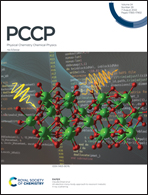Factors allowing small monovalent Li+ to displace Ca2+ in proteins†
Abstract
Because Li+ and Ca2+ differ in both charge and size, the possibility that monovalent Li+ could dislodge the bulkier, divalent Ca2+ in Ca2+ proteins had not been considered. However, our recent density functional theory/continuum dielectric calculations predicted that Li+ could displace the native Ca2+ from the C2 domain of cytosolic PKCα/γ. This would reduce electrostatic interactions between the Li+-bound C2 domain and the membrane, consistent with experimental studies showing that Li+ can inhibit the translocation of cytoplasmic PKC to membranes. Besides the trinuclear Ca2+-site in the PKCα/γ C2 domain, it is not known whether other Ca2+-sites in human proteins may be susceptible to Li+ substitution. Furthermore, it is unclear what factors determine the outcome of the competition between divalent Ca2+ and monovalent Li+. Here we show that the net charge of residues in the first and second coordination shell is a key determinant of the selectivity for divalent Ca2+ over monovalent Li+ in proteins: neutral/anionic Ca2+-carboxylate sites are protected against Li+ attack. They are further protected by outer-shell Asp−/Glu− and the protein matrix rigidifying the Ca2+-site or limiting water entry. In contrast, buried, cationic Ca2+-sites surrounded by Arg+/Lys+, which are found in the C2 domains of PKCα/γ, as well as certain synaptotagmins, are prone to Li+ attack.



 Please wait while we load your content...
Please wait while we load your content...